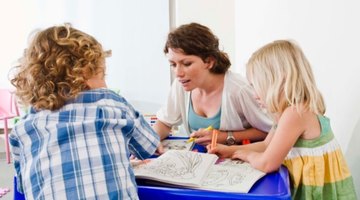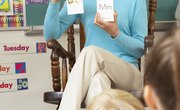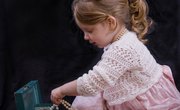Young children need an environment full of language to learn to read and communicate through speaking and writing. In a language-rich classroom, you can foster all aspects of language in young children. These aspects include learning new vocabulary and learning to use new vocabulary in speaking. Children also learn to use voice inflection and convey feeling through speaking. Writing is another aspect of a language rich environment. Children learn to speak and use language, then they learn how to put those thoughts down in writing. The importance of a print-rich classroom environment cannot be understated.
Vocabulary Creates a Language Rich Environment
Children develop language by taking in new vocabulary all the time. They learn words by listening to the people around them and watching for context cues. For example, you may be talking about how to make play dough, but the children may not understand what flour and salt are until the teacher gives them tangible items to attach the words to. Teachers who provide a language-rich classroom are talking constantly about what they are doing and providing the actual items so that children can put meaning to the words.
Reading Aloud Enhances a Language Rich Classroom
One of the most natural ways to teach children new vocabulary and methods of speaking is to read books aloud. Such a large a variety of books is available for young children that many lessons can be done for conveying feeling through speaking. You can read books about different types of feelings so that children learn what it sounds like to be happy, sad or angry. Children learn about the cadence of speaking through listening to books. Research based teaching involves multiple opportunities for students to read aloud in a classroom.
Imagination has a role in a Language Rich Classroom Too
Putting new vocabulary into authentic situations is best done through pretend play with young children. Children learn much from each other and need to practice situations they have seen and heard through books and watching adults. The most appropriate way to foster this use of new language is through pretend play. Set up situations in your classroom that provide opportunities to put new words and skills into practice. For example, if you read a book on taking care of animals, you could set up a veterinary clinic for pretend play.
Word Walls are on the Literacy Rich Environment Checklist
Writing is a large part of carrying over new language or supporting already learned words and ideas. Language-rich classrooms expose children to words in writing as well as out loud. For very young children, a word wall would display commonly used words and can be as simple as the names of all the children and teachers in the classroom. A picture clue for each word is appropriate as well. For children nearing school age, commonly used sight words would be appropriate to display on a word wall.
Modeling Helps Support Literacy in the Classroom
The most important aspect of teaching children language is to model everything. As their teacher, you can model how to use new words in sentences, model how to use new ideas in pretend play and model how to write words. A classroom can be decorated perfectly and filled with the most expensive supplies, but unless the teacher models how to use the materials and skills, those materials go to waste.
Related Articles
References
Writer Bio
Mary Johnson-Gerard began writing professionally in 1975 and expanded to writing online in 2003. She has been published on the Frenzyness Divorce Blog and on Neumind International Pte Ltd. Her book "When Divorce Hurts Too Long—Ouch" was published in 2009. Johnson-Gerard holds a doctorate in educational psychology from the University of Missouri.











